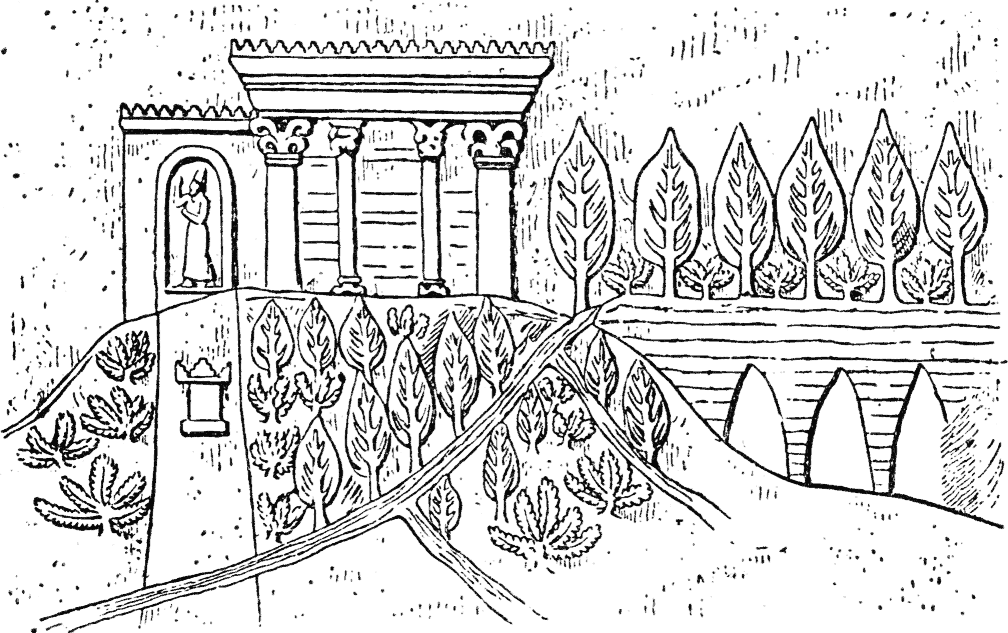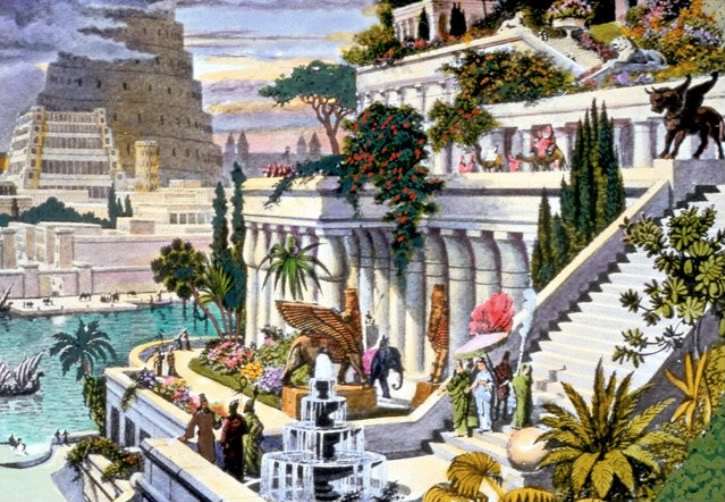It has been suggested that a 'walk through gardening time' would be interesting. So I'm proposing to post a series of potted histories that offer a very brief introduction to garden history around the world and down the millennia. The first gardens have been dealt with in an earlier post. So, let us start with the gardens of the Ancients.
Gardens are a Barometer of Civilisation
The cultivation of gardens has always required a settled and organised society, and the making of gardens acts as a barometer of civilisation.
An Egyptian Nobleman’s Garden
One of the best representations of an ancient Egyptian garden is a painting found on a tomb wall. In a hot, dry and dusty land, this garden was oasis in the desert. The link is to an artist's reconstruction of the garden. Enclosed behind a wall, the garden was shaded by trees, cooled by moving water, and ornamented by the symmetrical and edible planting scheme of sykomor fig, pomegranate, and palm. And occupying the whole of the centre of the garden was a great trellised area smothered with vines.
This is Paradise
The Assyrians, who inhabited what became Persia (Iran and Iraq of today) had contact with the Egyptians from about 1400 BC, built their gardens with artificial hills, pavilions and shrines surrounded by flower beds, canals and ponds. They also had a love of trees and the within these enclosed parks were groves formally planted with pines, cypress and other species.
This is Paradise
The Assyrians, who inhabited what became Persia (Iran and Iraq of today) had contact with the Egyptians from about 1400 BC, built their gardens with artificial hills, pavilions and shrines surrounded by flower beds, canals and ponds. They also had a love of trees and the within these enclosed parks were groves formally planted with pines, cypress and other species.
 |
| Ninveh c.690 BC |
The next dominant civilisation in this area was that of the Medes and Achaemenians (900-400 BC). These Persians continued to develop the parks along the same lines, but with increasing elaboration, and tree culture become elevated to a sacred occupation. These parks with their ornate pavilions, great abundance of fruit and ornamental trees, well-tended meadows, flowers and game, were the playgrounds of the lordly. Here within the idyllic landscape where the mind and body could be refreshed and the eye stimulated. There was also a new role for the parks - filled with beasts they became places in which to hunt. And from their name, pairadaeza, meaning enclosed space, we get our word ‘paradise’.
Hanging Gardens of Babylon
 |
| How the Hanging Gardens may have looked |
Not only did the Persians develop wonderful parks, but also they also created The Hanging Gardens of Babylon, which, with their complex terraces and intricate irrigation system, was one of the 7 Wonders of the Ancient World - although many archaeologists now agree that the terraced garden, which was probably drew its inspiration from the design of the ziggurat was not in fact built in Babylon.
Greece
 |
| Adonis Garden © Karlsruhe, Badisches Landesmuseum B39. Photo. Mus. R8057 |
Homer describes the garden of Alcinous, King of the Phoenicians as a productive garden, and while Alexander the Great may have assimilated many of the habits of the Persians he conquered, the Greeks seem never to have developed a garden making culture. Admittedly, plants had a religious significance – the gardens of Adonis, sacred groves and Diana’s woodlands, but their gardens were limited to the gymnasium, a shady area used for education and physical training. The next great civilisation to create gardens was the Roman Empire.

I am so pleased to have found your blog. I have a burgeoning interest in garden history. I've signed up for the distance learning course with Oxford and am currently reading Tim Richardson's Arcadian Friends which is very good
ReplyDeleteSo glad you are enjoying it! Tim's book is very good, and for an excellent overview of English garden history may I suggest Richard Bisgrove's The National Trust Book of the English Garden (ISBN 0670809322). Sadly its out of print but second hand copies are available on www.abebooks.com and amazon.
DeleteThank you for the "walk." I hoping it continues. And the recommendations to the prior comments sound very interesting. If the hanging gardens weren't in Babylon...where do the archaeologists think it was? Thank you.
ReplyDeleteHi Jacqui - the general consensus is that the garden was in fact constructed by king Sennacherib (r.701-681 BC) and not Nebuchadnezzar II (r.605-562 BC) and in Nineveh rather than Babylon.
DeleteThe following article has much more information, but I can't find a link for it: ‘Nineveh, Babylon and the Hanging Gardens: Cuneiform and Classical Sources Reconciled’ by Stephanie Dalley and published in the journal Iraq: vol. 56 (1994), pp. 45-58.
http://dl.lib.brown.edu/reserves/pdffiles/8810_Neneveh_Babylon.pdf
ReplyDeleteMany thanks 'Anonymous' for posting the link to Stephanie Dalley's article.
ReplyDelete